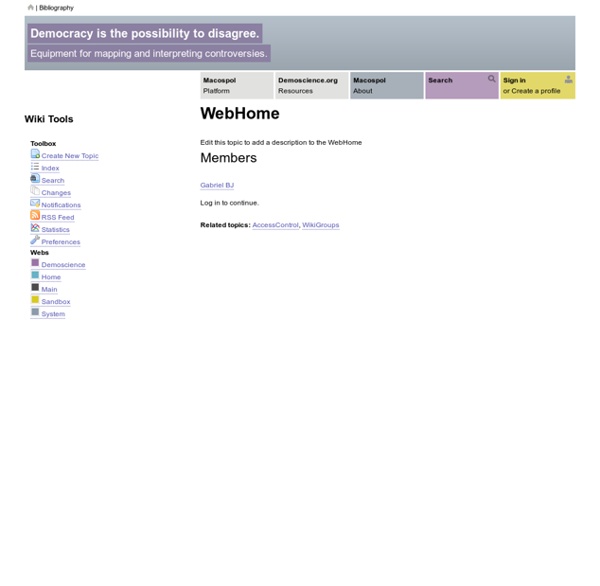



Risk Controversies visualized Last Update: Oct. 5th 2011 New brochure (german version) available online. Download PDF (2MB) The aim of the reseach project is to develop an internet based visualisation of risk related controversies as argumentation maps on the basis of two exemplary case studies: dietary supplements and nanoscale particles. These argumentation maps will be developed by an interdisciplinary research team of sociologists, natural scientists, computer scientists as well as partners and advisors from industry, poltics and academia. The research project is funded by the Federal Ministry for Education and Research (BMBF) within the social ecological research (SÖF) programme "Strategies to Cope with Systemic Risks". Since 2008 the Risk-Cartography is part of the far reaching EU-Project MACOSPOL - Mapping Controversies on Science for Politics .
El Cluetrain Manifiesto El Cluetrain Manifesto (el Manifiesto del tren de claves) es un compendio de 95 puntos acerca de la economía emergente en la Sociedad de la Información ordenadas y presentadas como un manifiesto, o un llamado a la acción, para todas las empresas que operan en un mercado con nuevas conexiones. Se trata de un texto fundacional, que plantea tempranamente la cuestión de las comunicaciones corporativas en oposición con las comunicaciones de las personas entre personas. Lo que muestra el manifiesto es que la Red facilita el desarrollo de un consumidor maduro porque el incremento de la información genera en el consumidor mayor capacidad de elección, mayor cotas de libertad para decidir si consume un producto o servicio y se relaciona o no con la empresa en función de la información que el mismo se proporciona. Es decir, los retos que plantea cuando las personas se apropian de los espacios. Markets Are Conversations. 1. 2. 3. 4. 5. 6. 7. 8. 9. 10. 11. 12. 13. 14. 15. 16. 17. 18. 19. 20. 21. 22.
ToolGoogleScraperFAQ What does the Google Scraper actually do? The Google Scraper is a piece of software which allows one to batch query Google. It allows a user to enter a set of URLs and a set of keywords. For each URL-keyword combination Google will be queried for [keyword site:! I’ve been setting the max number of hits to 1000 but it never seems to hit the maximum Question (continued): ... and I’ve noticed a lot of results in the order of 400-600. Why is the 'number of results per query' set to 100? The Google Scraper has the setting "Number of results per query (max 1000)". What is the difference between 'Retrieved by Google Scraper' and 'Estimated by Google' in the tag cloud output? In the resulting tag clouds one can choose to size the tags by 'Retrieved by Google Scraper' and by 'Estimated by Google'. Is it possible to run multiple scrapes simultaneously? No. Querying hosts and URLs If the box "only query discrete sites" is checked it will search the entire site. How can I verify the query made to Google?
Citymine(d) Gephi - The Open Graph Viz Platform cultural democracy . net wordcloud « Fells Stats An update to the wordcloud package (2.2) has been released to CRAN. It includes a number of improvements to the basic wordcloud. Notably that you may now pass it text and Corpus objects directly. as in: #install.packages(c("wordcloud","tm"),repos=" library(wordcloud) library(tm) wordcloud("May our children and our children's children to a thousand generations, continue to enjoy the benefits conferred upon us by a united country, and have cause yet to rejoice under those glorious institutions bequeathed us by Washington and his compeers.",colors=brewer.pal(6,"Dark2"),random.order=FALSE) data(SOTU) SOTU <- tm_map(SOTU,function(x)removeWords(tolower(x),stopwords())) wordcloud(SOTU, colors=brewer.pal(6,"Dark2"),random.order=FALSE) This bigest improvement in this version though is a way to make your text plots more readable. Notice how many of the state names are unreadable due to overplotting, giving the scatter plot a cloudy appearance. A big improvement! ...
'Occupy' dels béns comuns - Opinió - Al Jazeera en anglès The place in the central area of San Giovanni in Rome could make a lively sport complex with a variety of activities for all ages. Once the administrative headquarters for vehicle registrations and driver's licensing, it is a dismissed public building, now, technically speaking, an illegal place. Eight months ago, Scup (Sport e Cultura Popolare) as the space has been renamed, was occupied, cleaned up and brought back to life by a mixed group of young activists, sport instructors and some residents of the neighbourhood. They were outraged by the lack of public spaces for leisure and sport activities in an area that has become more and more gentrified while rental prices have soared. In Italy, the public sector downsizing has resulted not only in cutting public funds for culture, instruction and health care, but has also pushed speculation in the real estate market to grow. Many of them have been occupied by low-income families in need of a place to live. A new generation of occupations
Phoenix Data Project